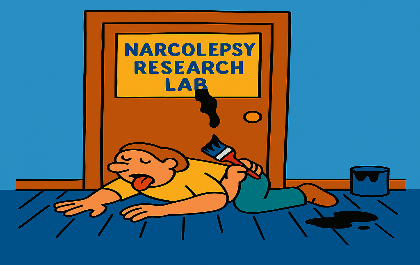Hypersomnia, or excessive daytime sleepiness (EDS), has emerged as a notable neurological complication in some individuals following SARS-CoV-2 infection, particularly in the context of Long COVID. While fatigue is more commonly reported, hypersomnia represents a distinct clinical entity with unique underlying mechanisms.
🔬 Etiology: How COVID Triggers Hypersomnia
1. Neuroinflammation and Autoimmunity
- COVID-19 can provoke autoimmune responses that target hypocretin (orexin)-producing neurons in the hypothalamus—similar to mechanisms seen in narcolepsy type 1.
- Elevated IL-6 and TNF-α cytokines disrupt sleep-wake regulation by impairing hypothalamic and brainstem circuits.
2. Direct CNS Involvement
- SARS-CoV-2 may enter the brain via the olfactory pathway, affecting regions like the brainstem, thalamus, and temporal lobes, which are critical for arousal and sleep regulation.
- MRI and EEG studies have shown hypoperfusion in these areas during symptomatic hypersomnia episodes3.
3. Circadian Rhythm Disruption
- Lockdowns, isolation, and altered light exposure during the pandemic disrupted zeitgebers (external cues), leading to circadian misalignment and hypersomnolence.
4. Post-Infectious Encephalopathy
- Inflammatory damage to sleep-regulating centers may persist after acute infection, contributing to central hypersomnia even in mild COVID cases.
🧪 Clinical Presentations
- Idiopathic hypersomnia: Prolonged sleep duration (>11 hours/day), sleep inertia, and non-restorative naps.
- Narcolepsy-like symptoms: Cataplexy, sleep attacks, and REM abnormalities in some post-COVID cases4.
- Kleine-Levin Syndrome (KLS): Rare relapses triggered by COVID, with hypersomnia, hyperphagia, and mood changes.
Long COVID hypersomnia is driven by a complex interplay of neuroinflammation, autonomic dysfunction, and circadian disruption:
- Neuroinflammation: Elevated cytokines (IL-6, TNF-α) suppress wake-promoting neurons in the hypothalamus and brainstem, particularly those producing orexin (a key wakefulness neurotransmitter).
- Glymphatic system dysfunction: Impaired clearance of neurotoxins during sleep leads to brain fog and shutdown-like episodes.
- Vagus nerve dysregulation: COVID-related damage causes misfiring signals that disrupt sleep-wake cycles.
- Mitochondrial damage: Reduced cellular energy in neurons contributes to fatigue and hypersomnia.
- Persistent spike protein: May interfere with orexin signaling and hypothalamic function2.
🧠 Brain Function Changes and EEG Findings
Recent studies using EEG, PET, and MRI have revealed measurable changes in brain activity among Long COVID hypersomnia patients:
| Finding | Implication |
|---|---|
| ↓ Nerve Growth Factor (NGF) | Reduced neuroplasticity and adaptability |
| ↑ IL-10 and IL-6 | Ongoing inflammation in sleep-regulating centers |
| ↓ EEG alpha activity | Suggests reduced cortical arousal and alertness |
| ↑ NREM Stage 1 sleep | Increased drowsiness and fragmented sleep |
| ↓ REM and deep sleep stages | Poor sleep quality and unrefreshing rest |
These changes mirror patterns seen in early neurodegenerative disorders, raising concerns about long-term cognitive impact4.
🩺 Therapeutic Strategies in 2025
🔹 Behavioral and Chronobiological Approaches
- Cognitive Behavioral Therapy for Insomnia (CBT-I): Effective for mixed insomnia/hypersomnia phenotypes
- Light therapy + melatonin: Resets circadian rhythm and improves sleep onset
- Chronotherapy: Aligns medication timing with sleep cycles
🔹 Pharmacologic Interventions
| Agent | Use Case |
|---|---|
| Modafinil/Solriamfetol | Wakefulness promotion for hypersomnia |
| Low-dose naltrexone (LDN) | Immune modulation and sleep depth |
| Oxybate (sodium oxybate) | Improves sleep quality and inertia |
| Methylphenidate | Daytime alertness and cognitive clarity |
🔹 Emerging Therapies
- Orexin agonists: Target narcolepsy-like symptoms
- Vagus nerve stimulation: Rebalances autonomic dysfunction
- Mitochondrial support: CoQ10, NAD+, B vitamins for energy restoration
📉 How Debilitating Is Long COVID Hypersomnia?
- A 2025 meta-analysis in BMC Neurology found 24.4% of Long COVID patients suffer from sleep disorders, with hypersomnia linked to significant activity limitations.
- Case studies report school absenteeism, loss of productivity, and social withdrawal due to uncontrollable sleep episodes8.
- Patients often experience brain fog, sleep inertia, and post-exertional crashes, resembling myalgic encephalomyelitis/chronic fatigue syndrome (ME/CFS).
🔄 Is It Permanent?
- Not always. Recovery depends on:
- Severity of initial infection
- Degree of neuroinflammation and microclot burden
- Access to multidisciplinary care (e.g. RECOVER-SLEEP trial)
- A review in Current Sleep Medicine Reports found that some patients recover within a year, while others require ongoing care and specialized therapies.
📚 Peer-Reviewed Sources
- RECOVER-SLEEP Trial Overview
- Sudden Sleep Collapse: COVID Long Haul Foundation
- Oxford Academic Case Report on Hypersomnia
- BMC Neurology Meta-Analysis
- Frontiers in Neurology Review
- EurekAlert on ME/CFS and Long COVID
- PLOS One Brain Inflammation Study
- MSU/Corewell Health Brain Fog Study
